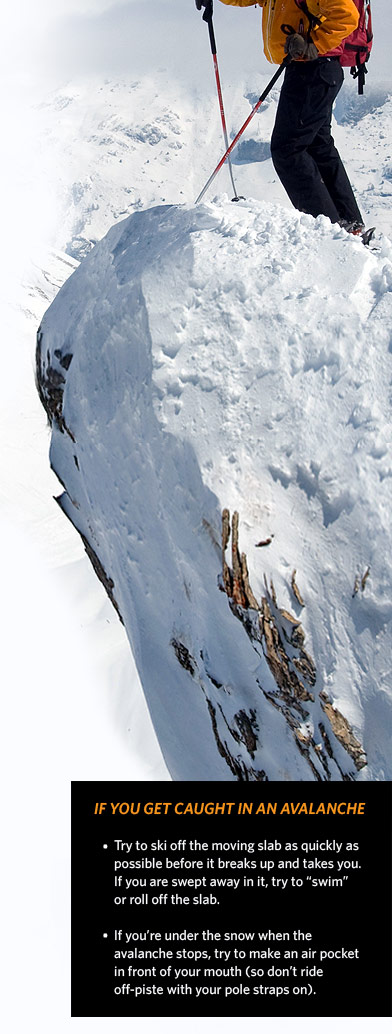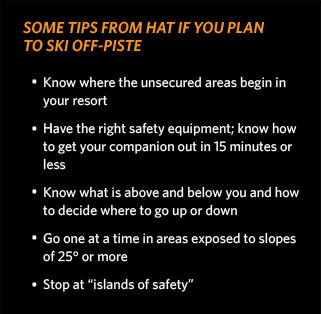Keeping Your Edge in Avalanche Country

By Jean Hennelly Keith
Each year, grim headlines tell of skiers and other winter sports enthusiasts who venture off-trail in high mountains and are swept up in avalanches. Victims—or someone in their group or in a group skiing above them—trigger 90 percent of avalanche accidents, and nearly 20 percent of those caught in avalanches die, amounting to more than 150 fatalities annually worldwide—and that number is rising.
The Alps top the list for these fatalities. Unlike the ski areas in the western United States, where avalanche risk is managed by blasting the entire area to release unstable snow slabs, in Europe blasting occurs only on the slopes above the “pistes” (ski runs) to protect them. Based in the world-class French Alpine ski resort Val d’Isère, Henry (Hank) Schniewind (CGS’86, CAS’89) is an avalanche and snow expert and “off-piste” (off-trail) guide who knows what it takes to ski safely on the steep, snowy slopes in avalanche territory.
He describes a slab avalanche as a “piece of cake on top of a layer of frosting, or a stronger layer of snow on a weaker one. The power of an avalanche is tremendous,” he says. “If you are skiing where a slab releases, you will be taken.”
Extreme adventure is a growing industry, Schniewind says, with more tourists now heading into the wilderness, whether or not they have the necessary skills, knowledge, or experience to handle the conditions. “Off-piste skiing has become trendy,” he says, “and lots of people are pushing the envelope. Some in seemingly tame areas don’t even realize that they’re endangering themselves or others.” Skiing off-piste requires training, and with the high number of deaths and injuries caused by mostly medium- and even small-sized avalanches each year, Schniewind has developed a program to meet this need.
In 2001 he created Henry’s Avalanche Talk (HAT), one of only a few private safety and risk management programs in the world dedicated to off-piste winter recreation. He and his team of ski professionals and guides train the intrepid, and sometimes foolhardy, how to venture off-trail for big-snow thrills without setting off avalanches, and if they do get caught in one, how to maximize their survival.
Why risk it? What’s the allure beyond the trails?
With the sunny glow of an outdoorsman, Schniewind, an American whose German name loosely translates to “snow wind,” describes the glory of off-piste skiing. “A sense of autonomy and adventure, freedom from being shepherded,” and being surrounded by fresh powder, open sky, and the soaring mountains, he says, is simply “the best. Especially just after a storm, when the snow hasn’t settled or bonded yet, skiing in light snow gives the sensation of grace, smoothness, weightlessness—you feel like you’re floating.” But he quickly adds, “This is often when it’s unstable, so choosing where you go is so important.”
He knows what he’s talking about. In 1984, while taking a pre-freshman semester with BU’s new Study Abroad program in Grenoble, France, he discovered the magic of skiing the majestic mountains of Val d’Isère and triggered an avalanche that nearly overtook him. Although an excellent skier, who as a youngster trained at the Green Mountain Valley School for skiers in Vermont and was a nationally ranked ski racer by age 15, Schniewind had a “high standard of skiing but no mountain knowledge,” he realized. After his close encounter, he set about filling that gap.

He calls his experience at Val d’Isère “key,” inspiring him to make a career in the mountains. Schniewind entered the College of General Studies (then called the College of Basic Studies) and soon began to shine as a student. Next, with a French major and geology minor at the College of Arts & Sciences, he took a junior year “abroad” to study avalanche forecasting and snow science at Montana State University. He says BU gave him the latitude “to combine a sport with an intellectual endeavor with a business.” Right after graduation, he headed to Europe to shape his “dream career.”
In France, he saw that skiers were getting caught in avalanches and dying right next to pistes, but that nothing was being done to educate them on how to avoid the perils. With advice from his former professors at MSU, he gave his first off-piste skiing safety slideshow and talk in 1989. Now boasting eight branches in France and the United Kingdom, HAT offers avalanche risk management and ski training, including Schniewind’s “Ride Hard, Ride Safe” talks. He envisions a worldwide HAT franchise, he says, “wherever there is deep snow—South America, Europe, the U.S., China, all over.”












